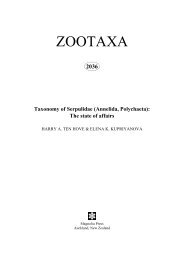You also want an ePaper? Increase the reach of your titles
YUMPU automatically turns print PDFs into web optimized ePapers that Google loves.
any apparent subepidermal fibers ............................................................................................................................. 20<br />
19 Peduncular bract surfaces ridged, brown tomentose, densely covered with short, recurved, markedly swollen-based,<br />
diagonally oriented spines; fruits 11.9(11.2–12.8) mm long; central Amazon region of Brazil and Colombia ............<br />
....................................................................................................................................................................... D. setosus<br />
- Peduncular bract surfaces ribbed, densely brown tomentose, without spines (very rarely with a few spines); fruits<br />
20.9(18.4–23.9) mm long; western Amazon region in Colombia, Peru, and Brazil ..................................... D. vacivus<br />
20 Fruit surfaces smooth, without any apparent subepidermal fibers ..................................................... D. polyacanthos<br />
- Fruit surfaces uneven with numerous, subepidermal, short, often branching (Y-shaped) fibers .............................. 21<br />
21 Peduncular bract surfaces deeply ridged, dark brown tomentose, sparsely covered with long, straight or sinuous<br />
spines, the bases scarcely swollen but running directly into the ridges of the bract and lying flat against the bract surface;<br />
Colombia (Amazonas, Vaupés) ....................................................................................................... D. interjectus<br />
- Peduncular bracts ribbed with several more prominent, lighter colored ribs, brown, scarcely or not tomentose, without<br />
spines (rarely with a few spines), or peduncular bract surfaces ridged, brown tomentose, sparsely to densely covered<br />
with spines; widespread, excluding Colombia .................................................................................................. 22<br />
22 Peduncular bracts ribbed with several more prominent, lighter colored ribs, brown, scarcely or not tomentose, without<br />
spines (rarely with a few spines); Peru (Loreto) ................................................................................. D. loretanus<br />
- Peduncular bract surfaces ridged, brown tomentose, sparsely to densely covered with spines; Peru (Madre de Dios,<br />
Ucayali), eastern Bolivia, Brazil (Goiás, Mato Grosso, Mato Grosso do Sul, Minas Gerais, Rondônia), and Paraguay<br />
(San Pedro) ................................................................................................................................................................. 23<br />
23 Pinnae bases with uneven surfaces at the bases adaxially, usually covered with spinules and/or dense tomentum;<br />
Peru (Madre de Dios, Ucayali) ................................................................................................................ D. madrensis<br />
- Pinnae bases with smooth surfaces adaxially, without spinules or dense tomentum ................................................ 24<br />
24 Endocarps globose to obovoid with rounded or slightly peaked apices; eastern Bolivia ......................... D. latisectus<br />
- Endocarps narrowly ellipsoid with rounded apices; Brazil (Goiás, Mato Grosso, Mato Grosso do Sul, Minas Gerais,<br />
Rondônia) and Paraguay (San Pedro) .................................................................................................... D. leptoclonos<br />
1. Desmoncus chinantlensis Liebm. ex Martius (1837–1837: 321).<br />
Atitara chinantlensis (Liebm. ex Martius) Kuntze (1891: 727).<br />
Lectotype (designated by Bailey 1933):—MEXICO. Oaxaca: Lacoba, Chinantla, no date, F. Liebmann 6595 (C, n.v.,<br />
lectotype image!).<br />
Desmoncus anomalus Bartlett (1935: 84). Type:—GUATEMALA. Alta Vera Paz: Secanquím, 29 April 1904, O. Cook &<br />
C. Doyle 97 (holotype US!). Synon. nov.<br />
Desmoncus lundellii Bartlett (1935: 84). Type:—GUATEMALA. Petén: near El Paso de Petén, 26 April 1932, C.<br />
Lundell 1555 (holotype MICH!).<br />
Desmoncus quasillarius Bartlett (1935: 85). Type:—BELIZE. Corozal: San Andres, July 1933, P. Gentle 348 (holotype<br />
MICH!).<br />
Desmoncus uaxactunensis Bartlett (1935: 86). Type:—GUATEMALA. Petén: Uaxactún, 18 April 1931, H. Bartlett<br />
12576 (holotype MICH!).<br />
Desmoncus ferox Bartlett (1935: 87). Type:—GUATEMALA. Petén: Tikal, 12–15 April 1931, H. Bartlett 12584<br />
(holotype MICH!).<br />
Plants 8.1(2.5–20.0) m tall; stems 2.5(1.4–3.8) cm diameter, solitary or clustered. Leaf petioles 2.2(0.5–4.7)<br />
cm long; rachises 108.0(96.0–128.0) cm long, 10.5(5.7–15.0) mm wide, the spines usually >1 cm long, mostly<br />
adaxial or lateral, straight with briefly swollen bases; pinnae 23(18–35) per side of rachis, without long,<br />
filiform apices, with an adaxial beard of spines at the bases, without spinules or dense tomentum at the bases<br />
adaxially; basal pinna 21.6(7.5–31.0) cm long, 1.9(1.0–2.5) cm wide; cirri well-developed, with<br />
acanthophylls, without spines abaxially, with intermediate acanthophylls present, without a wide gap between<br />
pinnae and acanthophylls. Inflorescences with the rachis ridged, not twisted, much thicker than the numerous,<br />
closely spaced and spirally or irregularly arranged rachillae, each rachilla not or only briefly adnate to the<br />
rachis, subtended by an acute bracteole and with a well-developed axillary pulvinus; peduncles 7.2(5.0–13.1)<br />
mm wide; peduncular bracts 37.3(26.5–69.0) cm long, broad, the surfaces ribbed, brown tomentose, sparsely<br />
to densely covered with long, straight or sinuous, briefly swollen-based, diagonally or vertically oriented<br />
spines, these flattened or triangular in cross-section, whitish-brown proximally, black or brown distally, with<br />
A REVISION OF DESMONCUS (ARECACEAE)<br />
Phytotaxa 35 © 2011 <strong>Magnolia</strong> <strong>Press</strong> 19
















